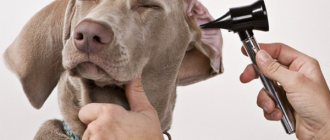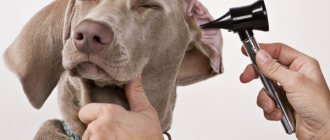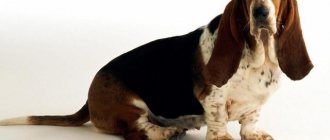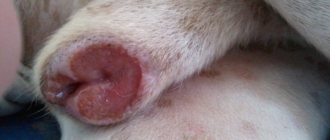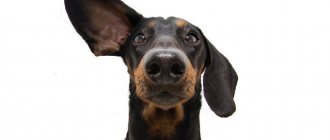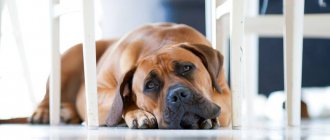Due to the specific structure of the ear, dogs are often susceptible to otitis media. Inflammation of the middle ear in dogs is often diagnosed; internal and external are less common.
The disease causes discomfort and severe pain to the pet. A visit to the veterinarian will help free the dog from uncomfortable sensations and prevent it from developing into a chronic form. An advanced disease can develop into complete deafness and provoke the death of a pet.
Root causes of otitis media
Otitis in a dog occurs for several reasons:
- Ear mites are a common cause of ear inflammation in dogs. Infection is possible from infected animals.
- A tumor becomes a provocateur of otitis media if it clogs the ear canal and interferes with the “ventilation” of the ear.
- Allergies to food, treats, medications and shampoo can lead to ear disease in your dog.
- A foreign object lodged in the ear. Often plant seeds, midges or blades of grass get into the ear, thereby causing otitis media in the dog.
The disease often develops due to insufficient care of the pet’s ears, but it also happens the other way around: excessive cleaning of the ears leads to the destruction of the protective layer, sebum and wax secretions.
The cause may also be weak immunity, bad teeth and hormonal imbalance.
Dog ear anatomy
A dog's ear canal consists of three parts: the outer, middle and inner ear . The outer ear - the part of the ear that we can see - is called foam and protects the inner parts of the ear, which house important structures that serve our dogs.
Important nerves and blood vessels also run through the inside of the ear and must be protected. Ear diseases can compromise these structures and cause permanent damage. This is why supporting your dog's ears is so important.
Predisposition of certain breeds to otitis media
Some breeds are more prone to this disease. Most often - dogs with large drooping ears: cocker spaniel, basset hound, dachshund and others. Drooping ears obscure the auditory opening and interfere with “ventilation,” which creates a “paradise” for the reproduction and life of pathogenic microbes.
East European Shepherds also often suffer from this disease. The structure of the ear does not prevent the penetration of dust and microorganisms into it.
Dogs with expressive folds on the muzzle, active swimmers, and those who live in high humidity climates are also at risk.
Allergy
Red spots, rashes on the ears, severe itching are signs of an allergic reaction to external irritants. Food, smells, and sun rays can trigger an exacerbation. First, the owner needs to identify the cause and eliminate it. Next, relieve discomfort with the help of veterinary medications prescribed by the doctor.
Note! Do not use medications from your home medicine cabinet to treat dogs without consulting your veterinarian. Instead of helping, you will cause great harm to your pet!
Symptoms
The owner can easily recognize the first symptoms of otitis media in a dog:
- often shakes his head, claws at the sore ear and reacts to touching it;
- upon examination, discharge with an uncharacteristic odor and swelling are noticeable;
- the ear is hot to the touch;
- The dog lies down more and turns away from the food.
If you notice such symptoms, you should consult a doctor.
Prevention
We must not forget about preventive measures. The ears should be washed with lotions or other products prescribed by the veterinarian. A similar procedure will be required for any dogs that have otitis media or have recently had it. To reduce the risk of developing such a disease, you need to regularly examine your pet's ears and clean them. It is best to do this once every 7-10 days. You should not use cotton swabs, because this can harm the animal's ear. It is recommended to carry out the procedure using cotton pads soaked in hydrogen peroxide or a special liquid.
You should always monitor the condition of your pet in order to contact a veterinarian in time and avoid possible complications. Discharge, a strong unpleasant odor and the dog's constant attempts to scratch its ears are causes for concern. In such a situation, all necessary measures must be taken to help the animal.
Diagnostics
During the examination, the doctor visually assesses the signs of otitis in the dog: the condition of the ears, nasopharynx, mouth and eyes. At the same time, asking questions about feeding, vaccinations and existing pathologies.
Be sure to have scrapings, ear discharge and blood tested. Laboratory tests will show the number of bacteria and parasites and determine their adaptability to medications. They will also determine your general condition and the possibility of allergies.
In some cases, radiography is used. This happens if the research is not informative enough. It shows the presence or absence of tumors and polyps in the nasopharynx. It is also possible to conduct a CT or MRI to exclude the possibility of brain inflammation. Some manipulations can be performed under general anesthesia.
Therapy is prescribed only based on test results. A specialist should tell you how to cure otitis media in a dog. Otherwise, the treatment will not bring results and will worsen the situation.
External manifestations
More accurately, the cause of ear odor can be determined by external signs. The main ones are the following:
- Squelches in the ear . With otitis media, pus accumulates, which, when pressed on the base of the ear, causes a characteristic squelching sound.
- Leaking from the ear . Also, a direct sign of otitis media is the leakage of sticky, odorous fluid from the auricle. It can be brown or white.
- Ichr . Ear mites, physical damage to the ear, or advanced otitis media cause bleeding.
- Discharge . Brown grains in the ear cavity are a sign of otitis media. If exudate is released from the ear, the color resembling coffee, then the pet is tormented by ear mites. Dark brown, smeared discharge in the ear indicates the formation of fungus and bacteria.
- Redness . It appears with any deviations from the norm. Inside the ear and outside.
- Peeling . The skin becomes dry and gradually begins to peel off. Perhaps the cause is an allergy.
- Itches . In most cases, diseases associated with the ears bring discomfort to the dog in the form of constant itching. Scabies is caused by insect bites, allergic reactions, fungus, and even dirt deposits.
- The dog shakes its ears . Constantly shaking the head or tilting the head to one side indicates otitis media. Also, the cause may be the same notorious ear mites or eczema.
Types of otitis media and their features
Depending on the causes of infection, otitis media transforms into different forms with different symptoms.
Purulent
Purulent otitis in dogs is expressed by discharge from the ears of a yellow-green substance with a sickly-sweet odor. If treatment is not treated in time, weeping ulcers form and the likelihood of damage to the integrity of the eardrum increases, which inevitably leads to deafness.
Chronic
This form of the disease is caused by staphylococcus and streptococcus bacteria. An animal with such a diagnosis needs careful and long-term treatment.
Otomycosis
So, they call fungal otitis media in dogs. Its development occurs for many reasons - reduced immunity, allergic reactions, various infections. Most often, this is a secondary disease that manifests itself as a result of improper treatment of other forms. The ear becomes red and hot, there is increased production of wax and an unpleasant sour odor. In the absence of therapy, the fungus spreads to the entire epithelium.
Bacterial
The development of otitis media in dogs occurs in a similar way to fungal infections. But spread over the entire surface of the skin occurs less frequently. Such otitis may be a complication after a viral infection - plague or enteritis. Accompanied by constant itching and discharge of pus.
Allergic
It is impossible to diagnose allergic otitis in dogs by eye; it can have symptoms of all available forms. The culprits are often food, shampoos, even household chemicals and pollen.
Traumatic
The cause may be a blow to the head, injuries after a fight, scratches and debris in the ear canal. When the wound becomes inflamed, pathological bacteria begin to multiply, which causes ear inflammation in the dog, treatment should begin as early as possible.
Parasitic
Fleas, ticks, lice eaters and other parasites damage the skin, and point inflammation starts.
Seasonal
In slushy weather, an increased content of sulfur is observed in the dog’s ears, which leads to the transformation of sulfur seals and the development of a bacterial infection against this background.
Why does my ear stink?
During the next cleaning of the dog’s ears, the responsible owner notices swelling, dirt, redness, smelly dark discharge from the ear or even a dense black coating; in especially advanced cases, pus flows and a sharp stench is felt, which indicates a disease.
At first, the dog occasionally scratches its ears, shakes its head and does not give in for affection, and later, when the moment of early detection of the disease is missed, the animal begins to experience severe pain and whine, in some cases even showing unusual aggression. Then the owners come to their senses and don’t know what to do.
So, why can your ears smell very unpleasant:
- Inadequate care.
- Cold water getting into ears.
- Walking in wooded areas where ticks may be present.
- Ignoring existing diseases.
- Insect or animal bites.
- Allergies - due to ingestion of plant pollen.
- Anatomical structure of the ears (standing short ears and hanging, long ears)
- Hematomas - ruptures, swelling after an impact.
- Bacteria and fungi (staphylococcus, streptococcus)
- Features of the breed.
For example, the German Shepherd synthesizes large amounts of sulfur, so a slight odor may occur. BUT: if your ears smell very strongly, then this is not normal, this should not happen in any case!
If your pet suddenly begins to perform the following actions, then you need to look for the causes of the disease and unpleasant stench in the ears:
- It scratches ears, sometimes until they bleed.
- Shakes his head.
- Loses orientation in space.
- Aggression towards affection.
- Decreased appetite.
- Apathy.
Internal symptoms:
- Purulent discharge.
- The ear is red and swollen inside, and at the same time it smells sharply and hurts.
- Neoplasms.
Treatment at home
If otitis media is detected in dogs, how to treat it at home? At first, you can alleviate your pet’s condition at home.
As home measures you can use:
- If there is severe scratching, the inner surface of the ear is wiped with hydrogen peroxide and carefully dried with a gauze bandage. Scratches are lubricated with brilliant green.
- If pus has accumulated and the ear “squishes,” you should carefully clean it with boric alcohol, blot it dry and cover it with streptocide powder.
- Dark plaque can be caused by mites. In this case, the auricle is freed from wax accumulations and lubricated with phenothiazine.
Manipulations should be carried out extremely carefully so as not to cause irritation in the affected areas.
Remember that self-treatment of otitis in a dog can lead to serious complications. Therefore, contacting a veterinarian is an important step.
What does the smell of fish and mushrooms mean?
This symptom indicates that the animal is infected with ear mites. It appears as a black coating on the mucous membrane. Also, if a dog's ears smell like fish, the owner may suspect he has a fungal infection. This pathology is always accompanied by severe itching and redness of the ears.
A stinky ear canal may also indicate other medical conditions. They can be identified by their nature:
- A sweetish smell, reminiscent of a rotten apple, indicates that your pet has otitis media. This disease may be accompanied by redness of the mucous membrane, as well as the appearance of brown discharge (in complicated forms of the disease). If inflammation of the auricle is not observed in the animal, then the stench signals problems with the liver.
- A rotten smell indicates excessive accumulation of dirt in the ear canal. Characteristic of shepherd dogs, as well as other breeds that produce large amounts of sulfur.
- A cheesy aroma indicates the development of a fungal infection. It may be accompanied by the formation of a white or greenish coating on the mucous membrane, reminiscent of curd mass.
- A sour smell indicates the presence of a bacterial infection.
It should be noted that if a stink appears from a pet’s ears, the dog owner must immediately take action: take the animal to the veterinarian, examine it and then follow all the doctor’s recommendations for treating the pet. Under no circumstances should you deal with this problem without the help of a veterinarian. Remember, any independent actions you take may not only not help you cope with the problem, but may also aggravate it. It is especially dangerous to use folk remedies for treatment if the dog shakes its head and liquid brown mud flows from the ear. This indicates severe damage or the presence of a complicated infectious disease.
Drops for otitis media
For the complex treatment of fungal otitis, drugs are prescribed that include miconazole, clotrimazole or nystatin.
The following anti-otitis drops for dogs are recommended for use:
- Surolan is an antimicrobial, anti-inflammatory and antiparasitic agent. You can use 3-5 drops twice a day. The course of treatment is 2-3 weeks.
- Aurizon fights bacteria and fungi. Apply 10 drops once a day for 1 week; if the symptoms do not disappear, the treatment is extended for the same period. Contraindicated for bitches expecting puppies.
- Otonazole is an antipruritic, antifungal agent. Use 3-5 drops once a day for 2 weeks.
- If the inflammation is caused by an allergen, antihistamine ear drops for dogs are used for otitis media.
- Sofradex – 2-3 drops, 3-4 times a day. Helps very well with swelling and itching.
- Anauran – 5 drops, 2-4 times a day. Indispensable for swelling and itching.
Treatment for suppurative otitis media in dogs is best done with antibiotic ear drops for dogs.
For example:
- Otibiovet – 4-5 drops. At the beginning of the development of the disease 3-4 times a day, after 3 days 2-3 times.
- Otipax – 4 drops, apply 2-3 times a day for ten days.
- Anandin , the dose here depends on the size of the pet. Dwarf breeds need 3 drops, medium breeds need 4 drops, and large breeds need 5 drops. The medicine is used for 3-4 days twice a day. It is required to repeat the course in a week, unless otherwise prescribed by your doctor.
The parasitic form requires treatment with insectoacaricidal agents.
- Leopard - 3 drops for dwarf dogs, 4 drops for medium-sized dogs and 5 drops for large dogs. Treatment is carried out twice with an interval of a week.
- Amitrazine is used once a day with an interval of 3 days. The procedure must be carried out until the signs disappear.
Otitis resulting from injury is treated with drugs that promote wound healing:
- Otopedin . Since these ear drops for dogs are quite toxic, the ears are treated once a week with 2-3 drops. After manipulation, the ears are fixed open for twenty minutes.
- Aurican needs to be dripped 5 drops for small dogs, 10-15 for medium-sized dogs, and 20 to 30 drops for large dogs. The drug is used daily for a week, then twice a week for another 25-30 days.
To make ear drops for dogs more effective, you need to follow some rules:
- Before the procedure, clean your pet’s ears;
- Warm the drops in the palm of your hand before use;
- when instilling, you need to pull the ear towards the spine, then press and massage a little.
What to do?
If a dog’s ears smell bad, then the most useful thing for the owner to do is to clean them with cotton swabs once a week, for dogs with short ears - more often, taking utmost care not to damage the eardrum and do an analysis of the ear flora .
If your ears are clean, there is no need to treat them! It is common to see dark brown, sticky wax in the ears, which is a natural defense against small debris and bacteria that cause inflammation. Getting rid of it is not difficult.
How to remove a slight odor? It is enough to clean your ears with a special lotion sold in a pharmacy, a solution of chlorhexidine, or saline solution (mix boiled water with a small amount of salt). You cannot clean your ears with hydrogen peroxide, because... You can irritate or even burn the delicate skin inside your ear canal!
To clean the ears of large dogs, it is better to use a cotton pad; for small dogs, it is better to use a cotton swab.
However, remember that wax itself protects the ear and even kills harmful bacteria! It is produced in the external auditory canal and, moving towards the auricle, absorbs dead skin cells, dust, and sebum.
A very important point: when cleaning, you cannot climb into the ear canal itself! This can only be done by a doctor using instruments designed for this purpose!
We can only clean the ear on our own, i.e. what's outside. There is sulfur there, which has already lost its beneficial properties and has become a favorable environment for the development of bacteria.
Why your dog smells like dog, fish or rotten meat: we solve problems quickly
Treatment with medications
Let's look at several effective schemes for treating otitis media in a dog. The proposed life examples will help you navigate and build the right treatment for your pet.
Option 1
Patient: large dog, weight 40 kg, age 4 years. Owner's complaints: does not allow petting on the head, the dog's ear hurts. Diagnosis: exudative otitis externa.
Local processing:
- Hydrogen peroxide. Using a damp swab, wipe the inside of the ear and the passage. Cleansing from crusts, pus and excess sulfur.
- Chlorhexidine. Wipe the ear treated with peroxide twice a day for half a month.
- Bepanten. Apply the ointment to the inside of the ear 2 times every 24 hours, for a course of two weeks. In severe situations, it is allowed to use Fluorocort or Lorinden.
- Sofradex - inject 3-5 drops into both ears twice a day for 14 days.
Parallel treatment:
- Sinulox or Clamoxil. Inject into the thigh once in the morning, 5-7 days, 4 ml.
- Suprastin. In the withers - inject 1 ml in the morning and evening - a weekly course.
- Serrata. It is necessary to inject 1 pill twice with an interval of 12 hours – 10 days.
Option 2
Patient: male, age – 7 years, weight – 12 kg. Owner's complaints: the dog is restless, his ear is leaking. Diagnosis: purulent otitis media in the chronic stage.
Local processing:
- Peroxide - twice a day, two weeks.
- Chlorhexidine - twice a day treatment for up to two weeks.
- Bepanten - twice a day for two weeks.
- Sofradex – 3-5 drops every 12 hours. The course of treatment is two weeks.
In a difficult situation, the following mixture of drops is acceptable:
Ceftriaxone 1 bottle + Dioxidin 10 ml + 5 ml Novocaine 0.5% + Suprastin 2 ml + Dexomethasone 3 ml + vitamin B12 2 ml + Dimexide 0.5-1 ml. This suspension should be administered 3-5 drops into both ears with a 12-hour interval. The course of treatment lasts 14 days.
At night, you need to apply a gauze swab soaked in the mixture: 2 ml of Lincomycin, 1 ml of Dexamethasone, Suprastin 1 ml and Novocaine 2% 3 ml. Treatment should continue for 10 nights.
Parallel treatment:
- Sinulox – intramuscularly 3 ml once, course of treatment – a week. Let’s say 1 bottle of Cefogram is mixed with Lidocaine 8 mg. Inject 2.5 ml of the prepared drug 1-2 times a day.
- Suprastin - inject 0.5 ml into the outer thigh, morning and evening for 7 days.
- Serrata - twice a capsule - no longer than 10 days.
- Liarsin – 1 pill 2 times a day – 10 days.
- Mezim – take 1 capsule twice a day for 12-14 days.
A blockade with novocaine at the root of the ear may also be useful. For this, novocaine 05% is used, 7 ml twice a day. Treatment duration is 1 week.
Antibiotics for otitis in dogs should be taken with caution, for example, if the eardrum is damaged, drops containing an ototoxic antibiotic are contraindicated.
Hematomas and tumors
Swelling on the ear or on the head near it can be the result of bruises, animal or insect bites, and sometimes - a manifestation of a separate disease. The dog becomes restless, tries to scratch the lump with its paw, and walks with its head tilted to the floor.
If you are sure of the origin of the pathology, try to help yourself: wash the abrasion (if there is one), treat the auricle with a special lotion (sold at a veterinary pharmacy), apply a thin layer of the veterinary drug Mastisan. The instructions do not say anything about dogs, but it relieves inflammation very well and usually does not cause allergies.
A doctor's help will be needed if the owner does not know what caused the lump. The dog needs to be examined. Surgery may be needed.
Preventive measures
In order not to wonder how to treat otitis in a dog, you should carefully monitor your pet.
For prevention purposes, the following measures should be taken:
- regular examination of the dog's ears;
- cleaning when dirty;
- plucking fur from the ear;
- Never rinse the ears of a healthy animal, this increases humidity in the ear;
- in slush and frost, pets with chronic otitis media should wear a hat;
- visit the veterinary office at least 2 times a year for a preventive examination.
We wish your pet a speedy recovery.
Prevention of ear diseases in dogs
The occurrence of this problem in pets can be avoided. To do this, it is enough to follow these rules:
- Clean your pet's ears regularly and treat them with a special lotion.
- Make sure that the animal does not roll in the mud. Avoid fighting with other pets.
- Always carefully examine the animal after a walk. Make sure that your Yorkie or a representative of any other breed does not have street dirt, branches, leaves, or hairballs left in their ears. All this can trigger the development of inflammation.
- Get regular checkups with your veterinarian. Perform deworming in a timely manner. Come for unscheduled consultations if you notice an unpleasant odor from your dog’s ears.
- Provide your pet with a balanced diet. His food must contain a lot of vitamins and beneficial microelements.
- Carefully wash your dog's ears, making sure that no water gets into them. If an animal has long hair growing on its head, it needs to be cut off near the ear canals. You can carefully cut it yourself or entrust this task to a veterinarian.
The presented recommendations should be followed by the owner of animals of any breed. However, they are especially important for those caring for a dog with floppy ears. They need to take their pets to the vet regularly to avoid any problems.
